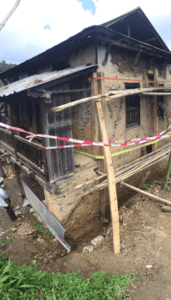RMS Impact Trek: Day 5 – Rebuilding Dhunkarka After the Earthquake
Build Change
Author

I’ll start with a broad idea (not my own) that I believe is generally true: all around the world, local architectural forms have grown organically, mostly out of rural communities, in response to distinct physical environments. A few examples: throughout the floodplains of Southeast Asia, homes rise on stilts to allow the monsoon floods to pass underneath. In the Alps, steeply pitched roofs shed heavy snows. And in the arid mountains of Peru, thick adobe walls keep homes cool during the day and warm at night. In the same way, Nepal’s buildings are largely a product of the land the Nepalese inhabit: in a country of hills and mountains, with few flat and open spaces, rather than sprawling across acres of land, rural homes go vertical: cooking and livestock on the ground floor, sleeping quarters on the second floor, and grain storage in the attic. As for materials: the roads that would ordinarily connect small towns to larger cities are frequently washed out by the rains; as a result, rural villagers (around 81% of Nepal’s population lives in rural areas) often forgo modern materials like steel and reinforced concrete in favor of mud and stone, which can be collected on site. The combination of these attributes – tall homes, with heavy walls built from weak and brittle materials – creates a vulnerability to earthquakes matched hardly anywhere else in the world.
In April 2015, the Mw7.8 Gorkha earthquake stuck between the two major cities in Nepal, Kathmandu and Pokhara. While both urban centers experienced some damage, it was really the rural communities – specifically, these homes made of mud and stone – that took the full force of the shaking. Driving through the countryside a few days ago, a year and a half after the event, the signs of damage are still very obvious, each one a dark cousin to the vulnerabilities above: collapsed walls, piles of broken earth and rock, and landslides across landscape as if it had been only a few weeks ago. It’s not terribly surprising that the recovery has been slow – few roads exist into these villages, and accessing them even to quantify the damage has been excruciating for the government and other organizations. Of the damage and loss estimates that exist, few even bother attaching a dollar value to these self-built homes. Aside from some support immediately after the event, the longer-term recovery of these rural areas has largely faded from the consciousness of the international community.
Village of Dhunkharka
And yet, the outlook for the villages is not entirely bleak. After the event, the Nepali government promised subsidies of around USD$2,000 for any homeowner whose house was severely damaged or collapsed in the earthquake. Just this week, the first installments (around $500) were disbursed to the first round of eligible homeowners, aiding homeowners and communities to hire builders to construct new homes. Although it may sound low, relative to Nepal’s GDP per capita ($732), the housing subsidy is quite substantial (by comparison, in 1989 after the Loma Prieta earthquake, FEMA offered loans – not grants – of $30,000 to homewoners, at a time when US GDP per capita was around $22,900). Still, the reality remains: to build a traditional mud and stone house – even without any additional earthquake-resistant features – costs $10,000 to $12,000. One in compliance with the Nepali code (the code allows unreinforced masonry homes) and the cost can rise to $15,000.
At the moment, the government’s official line is that the housing subsidy is given only for new home construction. Enter Build Change’s current project in Dhunkharka, a region about four hours southeast of Kathmandu. Here, Build Change engineers are working to demonstrate the technical viability of repairing and retrofitting existing homes that were damaged (but not collapsed) in the earthquake. So far, the results are promising – retrofitting an existing home, even with some repairs to damaged walls, costs significantly less than building a new code-based home (around $3,000 vs. $15,000), and construction is notably faster (around three weeks vs. two months), leading homeowners to have shelter more quickly. If the retrofit project were replicated at scale, it’s likely the total cost for each home could drop entirely within the subsidized amount from the government, if the government were to view repairs and retrofits as a feasible alternative to new construction. Right now, this is a big “if”.
Home repair and retrofit in progress in Dhunkharka
So, fingers crossed that the thoughtful engineering and construction Build Change is doing gains traction among local and national leaders. Whether this work is enabled by the Nepalese government may mean the difference between safe housing and no housing for hundreds and thousands of rural families affected by the earthquake.
Support resilient housing worldwide
Join us in preventing housing loss caused by disasters.
Donate nowNewsletter
Sign up for our newsletter to receive updates on our latest news, events, and more.

